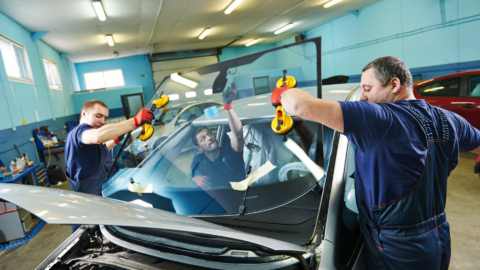Glass Replacement Supports Sustainable Building Practices
Glass replacement enhances sustainable building by improving energy efficiency, natural lighting, and thermal comfort, reducing environmental impact, lowering costs, extending building lifespan, and supporting eco-friendly, modern architectural design.
Oro Valley, AZ, United States, 28th Nov 2025 – Glass Replacement is becoming an essential strategy in modern construction for promoting sustainable building practices. By upgrading or replacing old, inefficient glass, buildings can significantly improve energy efficiency, reducing heating and cooling demands while minimizing environmental impact. High-performance glass replacement also enhances natural lighting, lowering the reliance on artificial lighting and contributing to energy conservation. Beyond energy savings, the process reduces waste by allowing materials to be recycled or repurposed instead of being discarded. Incorporating glass replacement into renovation and construction projects demonstrates a commitment to long-term sustainability, creating healthier, more comfortable spaces for occupants. This approach aligns functionality with eco-friendly building standards, making it a cornerstone of responsible architectural design.

Energy Efficiency Improvements
Glass Replacement plays a critical role in boosting energy efficiency in buildings. Old or damaged glass often allows heat transfer, increasing reliance on heating and cooling systems. By installing high-performance glass, thermal insulation improves, reducing energy consumption and associated emissions. Enhanced efficiency not only decreases utility costs but also aligns buildings with environmentally responsible standards. Incorporating energy-efficient glass into walls and windows minimizes temperature fluctuations, helping maintain a stable indoor climate. Over time, the improved performance of glass replacement reduces overall energy demand, supporting broader sustainability goals while creating a more comfortable and functional living or working environment.

Enhanced Natural Lighting
Upgrading glass through replacement contributes to optimal natural lighting in buildings. Modern glass solutions allow sunlight to penetrate effectively while controlling glare and heat, reducing the need for artificial lighting. Proper natural lighting improves occupant comfort and well-being while promoting energy conservation. By strategically using glass replacement, architects and builders can enhance indoor illumination, making spaces appear larger, more welcoming, and environmentally conscious. Increased daylight exposure also supports mental and physical health.
Maximizing Sunlight Penetration
Glass replacement allows sunlight to enter buildings efficiently, improving illumination while reducing reliance on artificial lighting. Strategic placement of high-quality glass enhances energy conservation, brightens interiors, and supports sustainable building practices by utilizing natural light to its fullest potential.
Controlling Glare and Heat
Modern glass solutions manage glare and heat, creating comfortable indoor environments. By replacing outdated or inefficient glass, buildings maintain balanced lighting levels, minimize overheating, and reduce energy consumption, ensuring spaces remain both functional and eco-friendly.
Improving Occupant Well-Being
Natural lighting positively affects mood, productivity, and overall health. Glass replacement enhances daylight exposure, supporting occupants’ mental and physical well-being while creating inviting, energizing spaces that align with sustainable construction practices and energy-efficient building design.
Reducing Electricity Dependence
High-performance glass minimizes the need for artificial lighting, lowering electricity usage and operational costs. Integrating glass replacement into building projects contributes to sustainability by cutting energy demand and promoting environmentally responsible design throughout residential and commercial spaces.
Enhancing Interior Aesthetics
Upgraded glass improves the visual appeal of interiors by creating brighter, more open spaces. Effective natural lighting from glass replacement makes rooms feel larger and welcoming, combining aesthetic enhancements with energy efficiency for modern, sustainable building solutions.
Thermal Comfort Management
Glass Replacement supports consistent thermal comfort by improving insulation and reducing heat transfer. High-performance glass regulates indoor temperatures, protecting against excessive heat in summer and retaining warmth during colder months. This enhances occupant comfort without relying heavily on mechanical heating or cooling, which reduces energy consumption. Proper thermal management also extends the lifespan of building systems and materials by mitigating stress caused by temperature fluctuations. Incorporating advanced glass technologies through replacement ensures buildings maintain stable and comfortable indoor environments. As a result, sustainable practices are reinforced, energy costs decrease, and long-term efficiency and comfort are achieved through effective building design.
Reduced Environmental Impact
Replacing glass contributes directly to reducing environmental impact in construction. Old, inefficient glass allows excessive energy consumption, increasing greenhouse gas emissions. By implementing high-performance glass replacement, energy use drops, and carbon footprints shrink. Additionally, replacing glass often involves recycling old materials, minimizing construction waste and conserving natural resources. These practices align with global sustainability objectives, emphasizing responsible material use and eco-conscious design. Sustainable glass replacement not only improves building efficiency but also demonstrates environmental stewardship. By prioritizing low-impact materials and energy conservation, structures can meet modern ecological standards, contributing to healthier communities and a reduced strain on natural ecosystems.
Material Sustainability Practices
Glass Replacement promotes material sustainability by encouraging the reuse and recycling of existing glass components. Instead of discarding outdated materials, responsible replacement practices recover and repurpose glass, reducing landfill contributions. New glass incorporates advanced technologies that enhance durability and performance while minimizing resource consumption. Sustainable material use through glass replacement ensures that construction projects adhere to green building principles. Selecting eco-friendly glass and following careful installation practices preserves resources, limits waste, and supports a circular economy. By integrating sustainable materials, projects achieve long-term resilience, reduce environmental pressure, and demonstrate commitment to environmentally responsible construction and design methods.
Long-Term Cost Savings
Investing in glass replacement provides significant long-term cost savings for building owners and occupants. Energy-efficient glass reduces heating, cooling, and lighting expenses, while durable materials require less maintenance and replacement over time. Improved insulation from modern glass decreases energy loss, stabilizing operational costs and extending the building’s lifecycle. Cost savings also come from minimized repairs and reduced strain on HVAC systems. By incorporating sustainable glass solutions, buildings achieve both financial and environmental benefits. The upfront investment in high-quality glass replacement is offset by lower energy bills, reduced maintenance, and longer-lasting performance, making it an economically sound component of sustainable building strategies.
Modern Architectural Integration
Glass Replacement enables seamless integration with modern architectural designs while supporting sustainability goals. Contemporary buildings rely on expansive glass elements to create visually striking and functional spaces. High-performance glass improves aesthetics without compromising energy efficiency or thermal performance. Replacing outdated glass allows architects to implement innovative designs while maintaining environmental standards. Glass replacement accommodates advanced glazing, coatings, and insulating properties that complement modern construction materials. By combining sustainability with design flexibility, buildings achieve both visual appeal and eco-conscious performance.
Lower Energy Expenses
Glass replacement with energy-efficient solutions reduces heating, cooling, and lighting costs. By improving insulation and regulating indoor temperatures, buildings minimize energy consumption, leading to significant long-term savings while supporting sustainable practices and reducing overall operational expenses.
Reduced Maintenance Requirements
High-quality glass materials are durable and require minimal upkeep. Investing in glass replacement decreases the frequency of repairs and replacements, extending the lifespan of windows and facades, lowering maintenance costs, and ensuring buildings remain functional and efficient over time.
Extended Building Lifecycle
Modern glass replacement strengthens structural performance and preserves building integrity. By limiting wear from temperature fluctuations and environmental exposure, energy-efficient glass helps prolong the lifecycle of the building, reducing renovation frequency and enhancing long-term economic and environmental benefits.
Minimized HVAC Strain
Upgraded glass reduces heat transfer, easing the workload on heating, ventilation, and air conditioning systems. This lowers energy use, decreases mechanical wear, and extends equipment life, contributing to both cost savings and more sustainable building operations over the long term.
Balanced Financial and Environmental Benefits
Investing in glass replacement offers both monetary and ecological advantages. Lower energy bills, decreased maintenance, and longer-lasting performance combine with reduced environmental impact, making sustainable glass solutions a smart, economically sound choice for responsible building design and management.
Conclusion
Glass replacement plays a pivotal role in advancing sustainable building practices by improving energy efficiency, enhancing natural lighting, and reducing environmental impact. Incorporating high-quality glass solutions into construction and renovation projects not only promotes long-term cost savings but also supports healthier, more comfortable indoor environments. Buildings in Oro Valley benefit greatly from thoughtful glass replacement, aligning modern design with eco-friendly strategies that contribute to a sustainable future.
For professional glass replacement services in Oro Valley, Vista Glass of Oro Valley is ready to help. Call us today at 520-800-1003 to schedule a consultation or learn how our expert team can support your sustainable building goals.
Vista Glass of Oro Valley
Oro Valley
520-800-1003
https://vistaglassorovalley.com/
Company Details
Organization: Vista Glass of Oro Valley
Contact Person: Vista Glass of Oro Valley
Website: https://vistaglassorovalley.com/
Email: Send Email
Contact Number: +15208001003
Address: Oro Valley, AZ
City: Oro Valley
State: AZ
Country: United States
Release Id: 28112538064
